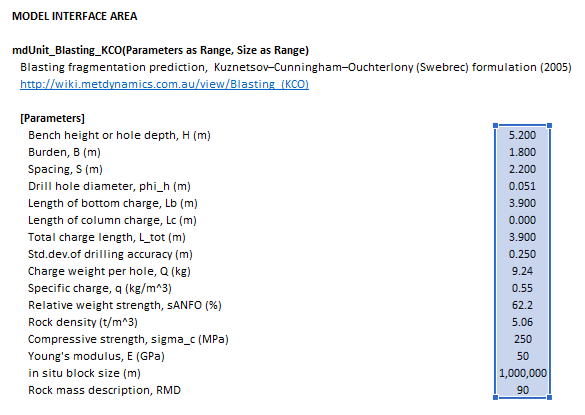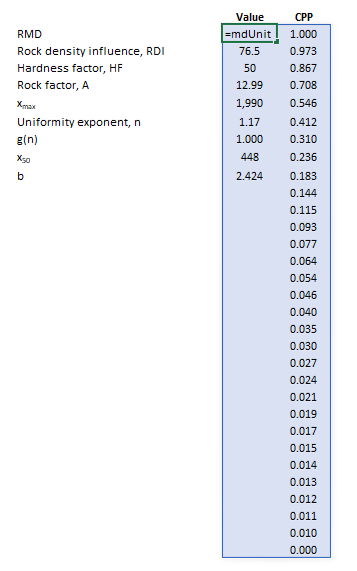Blasting (KCO): Difference between revisions
Jump to navigation
Jump to search
md>Scott.Munro m (→Inputs) |
imported>Scott.Munro mNo edit summary |
||
| (3 intermediate revisions by 2 users not shown) | |||
| Line 1: | Line 1: | ||
== Description == | == Description == | ||
This article describes the '''Kuznetsov–Cunningham–Ouchterlony''' (KCO) model (Ouchterlony, 2005) | This article describes the '''Kuznetsov–Cunningham–Ouchterlony''' (KCO) model (Ouchterlony, 2005) for predicting rock fragmentation by blasting.{{Ouchterlony (2005)}} | ||
== Model theory == | == Model theory == | ||
{{ | {{Restricted content}} | ||
<hide> | |||
</hide><div class="user-show"> | |||
=== Swebrec distribution === | |||
</div><hide> | |||
[[File:BlastingKCO4.png|thumb|425px|Figure 1. Schematic of blast design geometry (after Bergman, 2005).{{Bergman (2005)}}]] | |||
The KCO model links blasting conditions to the particle size distribution of fragmented rock via the three-parameter [[Distributions#Swebrec|Swebrec function]]: | |||
:<math>P_i = \dfrac{1}{1 + \left [ \dfrac{\ln \left ( \dfrac{x_{\rm max}}{d_i} \right )}{\ln \left ( \dfrac{x_{\rm max}}{x_{50}} \right )} \right ]^b }</math> | |||
where: | |||
* <math>i</math> is the index of the size interval, <math>i = \{1,2,\dots,p\}</math>, <math>p</math> is the number of size intervals | |||
* <math>P_i</math> is the cumulative fraction passing size interval <math>i</math> | |||
* <math>d_i</math> is the size of the square mesh interval that mass is retained on (mm) | |||
* <math>d_{i+1}<d_i<d_{i-1}</math>, i.e. descending size order from top size (<math>d_{1}</math>) to sub mesh (<math>d_{p}=0</math> mm) | |||
* <math>x_{\rm max}</math> is the maximum (top) size of the distribution, i.e. the maximum block size (mm) | |||
* <math>x_{50}</math> is the mean size (passing 50%) of the distribution (mm) | |||
* <math>b</math> is a curve-undulation exponent. | |||
Figure 1 outlines the primary blast design dimensions relevant to the KCO model. | |||
</hide><div class="user-show"> | |||
=== Maximum block size, ''x''<sub>max</sub> === | |||
</div><hide> | |||
The maximum block size is the smallest value of the ''in situ'' block size, the blast-hole burden, <math>B</math>, and the spacing, <math>S</math>, (m), i.e.: | |||
:<math>x_{\rm max} = \min \{ \textit{in}\text{ }\textit{situ}\text{ block size}, S, B \}</math> | |||
</hide><div class="user-show"> | |||
=== Mean size parameter, ''x''<sub>50</sub> === | |||
</div><hide> | |||
The mean size of the distribution, <math>x_{50}</math> (mm), is estimated by: | |||
:<math>x_{50} = \dfrac{g(n) \cdot A \cdot Q^{\frac{1}{6}} \cdot \left (\dfrac{115}{s_{\rm ANFO}} \right )^{\frac{19}{30}}}{q^{0.8}} \cdot 10</math> | |||
where: | |||
* <math>A</math> is the rock mass factor | |||
* <math>Q</math> is the charge weight per hole (kg) | |||
* <math>s_{\rm ANFO}</math> is the explosive’s weight strength relative to ANFO (%) | |||
* <math>q</math> is the specific charge (kg/m<sup>3</sup>) | |||
* <math>g(n) = 1</math> is assumed | |||
* The 10 factor converts Ouchterlony's ''centimeter'' units to ''millimeters''. | |||
The rock mass factor, <math>A</math> is: | |||
:<math>A = 0.06 (\mathit{RMD} + \mathit{RDI} + \mathit{HF})</math> | |||
The rock mass description,<math>\mathit{RMD}</math>, is: | |||
:<math>\mathit{RMD} = | |||
\begin{cases} | |||
10 & \text{Powdery/friable}\\ | |||
\mathit{JF} & \text{Vertical joints}\\ | |||
50 & \text{Massive}\\ | |||
\end{cases} | |||
</math> | |||
The joint factor, <math>\mathit{JF}</math>, | |||
:<math>\mathit{JF} = \mathit{JPS} + \mathit{JPA}</math> | |||
where the joint plane spacing, <math>\mathit{JF}</math>, is related to the average joint spacing, <math>S_{\rm J}</math> (m), by: | |||
:<math>\mathit{JPS} = | |||
\begin{cases} | |||
10 & S_{\rm J}<0.1\text{ m}\\ | |||
20 & 0.1\text{ m}<S_{\rm J}\leq\text{oversize }x_{\rm o}\\ | |||
50 & S_{\rm J}>\text{oversize }x_{\rm o}\\ | |||
\end{cases} | |||
</math> | |||
The joint plane angle, <math>\mathit{JPA}</math>, is: | |||
:<math>\mathit{JPA} = | |||
\begin{cases} | |||
20 & \text{Dip out of face}\\ | |||
30 & \text{Strike perpendicular to face}\\ | |||
40 & \text{Dip into face}\\ | |||
\end{cases} | |||
</math> | |||
The rock density influence, <math>\mathit{RDI}</math>, is: | |||
:<math>\mathit{RDI} = 0.025 \rho - 50</math> | |||
where <math>\rho</math> is the rock density (kg/m<sup>3</sup>). | |||
The hardness factor, <math>\mathit{HF}</math>, is: | |||
:<math>\mathit{HF} = | |||
\begin{cases} | |||
\dfrac{E}{3} & E<50\\ | |||
\dfrac{\sigma_{\rm c}}{5} & E \geq 50\\ | |||
\end{cases} | |||
</math> | |||
where <math>E</math> is Young's Modulus (GPa) and <math>\sigma_{\rm c}</math> is the compressive strength of the rock (MPa). | |||
</hide><div class="user-show"> | |||
=== Curve-undulation exponent, ''b'' === | |||
</div><hide> | |||
The curve-undulation exponent <math>b</math> is determined from: | |||
:<math>b = \left [ 2 \ln 2 \cdot \ln \left ( \dfrac{x_{\rm max}}{x_{50}} \right ) \right ] \cdot n</math> | |||
where: | |||
:<math>n = \left (2.2 - \dfrac{0.014 B}{\varnothing_{\rm h}} \right ) \cdot \left (1 - \dfrac{\mathit{SD}}{B} \right ) \cdot \sqrt{\dfrac{\left( 1 + \dfrac{S}{B} \right )}{2}} \cdot \left [ \dfrac{\left\vert L_{\rm b} - L_{\rm c}\right\vert}{L_{\rm tot}} + 1 \right ]^{0.1} \cdot \left ( \dfrac{L_{\rm tot}}{H} \right )</math> | |||
and: | |||
* <math>\varnothing_{\rm h}</math> is the drill-hole diameter (m) | |||
* <math>L_{\rm b}</math> is the length of bottom charge (m) | |||
* <math>L_{\rm c}</math> is the length of column charge (m) | |||
* <math>L_{\rm tot}</math> is the total charge length (m) | |||
* <math>H</math> is the bench height or hole depth (m) | |||
* <math>\mathit{SD}</math> is the standard deviation of drilling accuracy (m). | |||
</hide> | |||
== Excel == | == Excel == | ||
The | The KCO blasting model may be invoked from the Excel formula bar with the following function call: | ||
<syntaxhighlight lang="vb">=mdUnit_Blasting_KCO(Parameters as Range, Size as Range)</syntaxhighlight> | <syntaxhighlight lang="vb">=mdUnit_Blasting_KCO(Parameters as Range, Size as Range)</syntaxhighlight> | ||
| Line 24: | Line 146: | ||
B\text{ (m)}\\ | B\text{ (m)}\\ | ||
S\text{ (m)}\\ | S\text{ (m)}\\ | ||
\ | \varnothing_{\rm h}\text{ (m)}\\ | ||
L_{\rm b}\text{ (m)}\\ | L_{\rm b}\text{ (m)}\\ | ||
L_{\rm c}\text{ (m)}\\ | L_{\rm c}\text{ (m)}\\ | ||
L_{\rm Tot}\text{ (m)}\\ | L_{\rm Tot}\text{ (m)}\\ | ||
\ | \mathit{SD}\text{ (m)}\\ | ||
Q\text{ (kg)}\\ | Q\text{ (kg)}\\ | ||
q\text{ (kg/m}^3\text{)}\\ | q\text{ (kg/m}^3\text{)}\\ | ||
| Line 35: | Line 157: | ||
\sigma_{\rm c}\text{ (MPa)}\\ | \sigma_{\rm c}\text{ (MPa)}\\ | ||
E\text{ (GPa)}\\ | E\text{ (GPa)}\\ | ||
\text{ | \textit{In}\text{ }\textit{situ}\text{ block size (m)}\\ | ||
\ | \mathit{RMD}\\ | ||
\end{bmatrix},\;\;\;\;\;\; | \end{bmatrix},\;\;\;\;\;\; | ||
| Line 42: | Line 164: | ||
d_{1}\text{ (mm)}\\ | d_{1}\text{ (mm)}\\ | ||
\vdots\\ | \vdots\\ | ||
d_p\text{ (mm)}\\ | |||
\end{bmatrix} | \end{bmatrix} | ||
</math> | </math> | ||
=== Results === | === Results === | ||
| Line 75: | Line 176: | ||
\begin{bmatrix} | \begin{bmatrix} | ||
\ | \mathit{RMD}\\ | ||
\mathit{RDI}\\ | |||
x_{\rm | \mathit{HF}\\ | ||
x_{\rm max}\text{ (mm)}\\ | |||
n\\ | n\\ | ||
g( | g(n)\\ | ||
x_{50}\text{ (mm)}\\ | x_{50}\text{ (mm)}\\ | ||
b\\ | b\\ | ||
| Line 87: | Line 189: | ||
\begin{array}{c} | \begin{array}{c} | ||
\begin{bmatrix} | \begin{bmatrix} | ||
\mathit{ | \mathit{P}_1\text{ (w/w)}\\ | ||
\vdots\\ | \vdots\\ | ||
\mathit{ | \mathit{P}_p\text{ (w/w)} | ||
\end{bmatrix} | \end{bmatrix} | ||
\\ | \\ | ||
| Line 99: | Line 201: | ||
\end{bmatrix} | \end{bmatrix} | ||
</math> | </math> | ||
=== Example === | === Example === | ||
| Line 119: | Line 212: | ||
| [[File:BlastingKCO3.png|left|frame|Figure 3. Example showing the selection of the '''Results''' (light blue frame) array in Excel.]] | | [[File:BlastingKCO3.png|left|frame|Figure 3. Example showing the selection of the '''Results''' (light blue frame) array in Excel.]] | ||
|} | |} | ||
== See also == | |||
* [[Distributions#Swebrec|Distributions (Swebrec)]] | |||
== References == | == References == | ||
[[Category:Excel]] | [[Category:Excel]] | ||
Latest revision as of 08:34, 1 May 2025
Description
This article describes the Kuznetsov–Cunningham–Ouchterlony (KCO) model (Ouchterlony, 2005) for predicting rock fragmentation by blasting.[1]
Model theory
Swebrec distribution
Maximum block size, xmax
Mean size parameter, x50
Curve-undulation exponent, b
Excel
The KCO blasting model may be invoked from the Excel formula bar with the following function call:
=mdUnit_Blasting_KCO(Parameters as Range, Size as Range)
Invoking the function with no arguments will print Help text associated with the model, including a link to this page.
Inputs
The required inputs are defined below in matrix notation with elements corresponding to cells in Excel row () x column () format:
Results
The results are displayed in Excel as an array corresponding to the matrix notation below:
Example
The images below show the selection of input arrays and output results in the Excel interface.
See also
References
- ↑ Ouchterlony, F., 2005. The Swebrec© function: linking fragmentation by blasting and crushing. Mining Technology, 114(1), pp.29-44.






